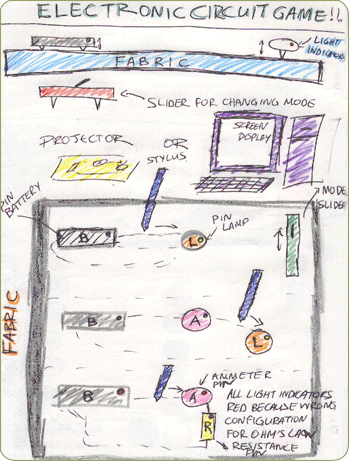Electronic Circuit Game
- provide a tangible, portable multi users learning environment
- provide fun
- two different versions
 PACT Analysis
PACT Analysis
People: Possible users are children, teens, their parents and other adults such as teachers. The group of students (children, teens) as well as the teachers is quite crucial as they are the direct users of this prototype. They have very specific needs and when a system is for educational reasons and entertainment it becomes more complex.
The prototype must be smartly designed to be both educational and relaxing. Special attention and focus should be given to children and teens with special capabilities or disabilities.
The prototype should be as simple as possible to be manipulated easily by all of them. It should not have complex procedures. Also, the different backgrounds should be considered. Focus on the importance of security and safety especially for the small children because they tend to be more vulnerable in accident and are not that careful. There should be maybe some flexibility in the use of pins and this is because kids usually tend to lose pieces of their games.
Activities: In general, it should give knowledge of how a simple circuit is built and maybe it could come in also a more advanced version for advanced learners. Students should use the different pins to construct several electronic circuits.
The Pins would represent different pieces of a circuit. They should have light and/or sound indicators to show if a circuit was built successfully or not. So, the whole process involves several iterative activities: construct and reconstruct an electronic circuit. The pins have to just be placed/replaced on the Fabric as well as be removed when necessary. The activities performed may or may not need cooperation as they may involve more than one player (although in more cases the players/users would be only one). The players do not need to enter by hand a specific type of data as this is performed somehow automatically with the choice of the Pins that they decide to place on the Fabric.
Contexts: The activityof playing the Electronic Circuit Game it could happen anywhere, either indoors or outdoors. It may be “played” either in school, at home, or somewhere else. The prototype should be again quite safe and resistant to several “dangerous” circumstances such as accidents occurrence (water/dust resistant). The Pins should be “programmed” in a quite flexible way so as to be somehow able to be recovered missed pieces/pins. Fabric is itself quite strong and not that vulnerable to misuse. Pins should not harm students and the other possible users.
Technologies : The data that has to be input is not that complicated to be entered from the users’ point of view as it does not involve typing something. It just operates when the Pins are placed in specific areas/points on the Fabric. However, the way that pins have to be placed needs to be quite clear. The output also is easily to be interpreted as both visual and acoustic ways are used to indicate this. These follow the “usual” and “internationally” accepted ways to interpret the success and failure.
The system should make explicitly clear when a circuit is built successfully or not. Also, it should show the wrong placed components so as the users to be able to learn the right configurations. The system could have two versions: one for novice circuit learners and another for more advanced. The separation of the two versions should be made clear each time and there should be no chances of misunderstanding. In case the latter happens, the system should be able to “show” to the users in which version it operates.